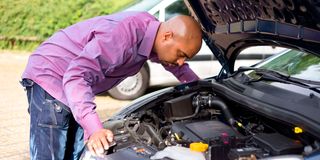An oil bath pre-cleaner will help your air filter last longer…but does your engine have space for it?

It is important to recognise that the “dirt” that needs to be filtered from the air to protect your engine and avoid polluting its oil are not just the dust and grit you can clearly see, but also particles that are not visible.
Gavin,
Much of my motoring is in extremely dusty conditions East of Mt Kenya. I have to regularly clean my air filter and frequently replace it. Is there anything I can do to still protect my engine but make the filter last longer?
Robert

Air filter.
Yes, there is an effective solution at quite modest cost…if you can find the right space in your engine compartment: fit an oil bath “pre-cleaner” that scrubs the air before it enters the standard paper element filter.
In the old days, everywhere was dusty and the oil bath was the only filter on all vehicles. It is just a tank with scrumpled wire mesh (or other fibrous material) in it, partly filled with oil which splashes around when the vehicle is moving.
Paper element air cleaners were introduced in the 1960s because they are smaller (there is less space in the engine compartments of modern cars) lighter, less-labour intensive to replace (labour is very expensive in the Western world), and in gentler motoring environments, they last about a year before they need to be (very carefully) cleaned or replaced.
Oil baths are still used on trucks and earth-moving/construction equipment, either solely or as pre-cleaners because there is more room for them and such vehicles work in dusty environments. Designs and filter materials have also been upgraded.
It is important to recognise that the “dirt” that needs to be filtered from the air to protect your engine and avoid polluting its oil are not just the dust and grit you can clearly see, but also particles that are not visible.
So, although some dirt that clogs paper element filters can be partly cleaned, they can still be partly blocked by millions of smaller particles and are not good-as-new. And the cleaning process can damage the filter material (tear it at a micro level) if cleaning is not done carefully and correctly.
Remove the element and gently tap it on a clean surface to shake off the heavier dust. Do not use fluids or chemicals of any kind. Use air pressure to remove more and smaller particles, but never direct the pressure “jet” directly at the paper element material. Place the filter on a clean flat surface and direct the air at the open surface in the middle of the filter so the pressurised air is deflected more broadly and from inside to out.
In extremely dusty conditions, logic suggests that it could be helpful to tape porous cloth (like a handkerchief?) over the outside of the air intake to stop the heavier dirt. The piece of cloth can be cleaned as often as necessary by simple washing and drying.
Be sure to tie or tape the cloth over the air intake nozzle very securely, so it is not sucked into the main body of the air cleaner pot. Your element filter will look a lot cleaner as a result, but remember, millions of micro particles will still have got through your outer barrier.
The oil bath pre cleaner is a better option…if there is room for it.

Imported cars at a yard. Most vehicle recalls happen when a new model has just been launched for the first time.
Why doesn’t Kenya have any new vehicle recalls?
Dear Bennett,
Every now and then we read cases of vehicles being “recalled” by source manufacturers to fix a design fault, but I have never heard of this happening in Kenya. Why so?
Kind Regards, M. Kiiru
Most recalls happen when a new model has just been launched for the first time (almost always in a major market where sales quickly run into thousands) when a design fault that was not spotted by extensive pre-launch testing is revealed by an unusual number of customer complaints or warranty claims related to a singular problem.
Sometimes a defect is not immediately apparent and emerges only after several thousand kilometres of use. It can take a while for this to happen, and for the number of complaints to build up to a level that demands remedial action to fix the fault and defend brand reputation.
In either case, the manufacturer promptly assesses whether the defect applies to just some of the vehicles (just a bad batch of a particular component) or potentially all of them (a fundamental design problem). Based on that answer, and exactly what the problem is (whether it is safety-critical or just a technical quirk) and how complex the fix might be, the manufacturer has a number of options:
One, to make no public statement, but to warn all its showrooms and service agents to change the defective part free of charge when each vehicle comes in for its first service, or to immediately accept any warranty claim on that part later on.
Two, to tell customers that the part will be upgraded under warranty if it gives any problem.
Three, and only as a last resort on the most safety-critical issues because the attendant publicity is so negative and the cost can be very high, the manufacturer can issue a general “recall”, with differing degrees of urgency. The costs are not just the repair/replacement, but possible lawsuits for compensation for accidents…or worse.
In each of these steps, the manufacturer will engage expert “actuarists” to estimate the likely costs and possible consequences of each option – broadly the risks of doing nothing versus the costs of correcting everything. To understand how that unconscionable business-is-business system works, I commend you to a film called Class Action.
Kenya is very unlikely to have a recall because we import so few new cars (a fraction of 1 percent of global production), and because even those are models that have been put to the test elsewhere in huge numbers for some time before they come to this market. Any original design defects have long-since been revealed and addressed…one way or another.

The family car is back with a new name: ‘SUV’
Hello Gavin,
It’s time to let my old X-Trail rest. Bought second-hand, it has served me well for nine years. I need a car for my children (8 and 11yrs) and myself for regular daily stuff, about 200km a week on Nairobi tarmac and 2-3 upcountry murram road trips a year. I prefer to buy a new car with a maximum spend of Sh3.5M. All I insist on is good ground clearance, a hatchback boot and at least 1500cc. I have only looked at the Toyota Urban Cruiser GLX R5. What’s your opinion of it and have you other suggestions? Joy K
The Toyota Urban Cruiser GLXR5 is a re-badged Suzuki Vitara Brezza, aka Maruti Suzuki Brezza. From spec sheets, user feedback and Toyota/Suzuki brand standards, either would tick all your boxes admirably. Many major brands offer similars.
Not too big or too small, and not too fancy or specialised in any respect. Just a get in and go and do all the things you need to get done. Reliably, sustainably, affordably, safely, comfortably. That’s what all mid-sized “family cars” used to be, because it is what just about everybody always has and still does want.
For people motoring in Kenyan conditions, those qualities went away for a while as road conditions in the world’s biggest markets changed from country lanes and B roads to Motorways, very small cars became the urban fashion, muscle cars and Chelsea Tractors became the stand-outs, and marketing focussed on specialised aspects of performance or economy, stylish cosmetics, fully-loaded extras, aerodynamics, safety regulation features and the latest technology – all things that motorists liked, but did not fundamentally need. And sometimes at the expense of the basics and multi-purpose versatility.
While all those tweaks persist, universal demand for the basic qualities you list did not go away. So the “family car” has been re-imagined in the category first called a “cross-over” and now blended as an SUV. And SUVs are now the modern and ubiquitous “family car”. They come in different sizes and have all sorts of optional variants, but at core they are five-seaters with a high-back hatch, good ground clearance and mostly a mid-sized engine.
They are more versatile than a saloon and less bulky than an estate. They are not the absolute best at anything, but they are competent at almost everything. They also have a better ride height than saloons for the driver’s eye-level and adopt modern technology (to optional degrees) where advances are most useful and practical.
They do not have any status stigma, either too high or too low, and do not expect either drivers or mechanics to be NASA-equipped rocket scientists. Exactly what you want exists…in abundance. And the one you have checked is at, or near the top of its category leaderboard.
Correctly fitted wheel nuts should never come loose

Correctly fitted wheel nuts should never come loose.
On a long journey home with my family one evening, I heard a crazy sound from the left front wheel. I stopped and found nothing at all. I drove again and the noise got worse so I drove on slowly to a garage. The mechanic asked me if I was on a death mission! The wheel nuts were loose. Did someone want to mess with me or do wheel nuts begin to loosen on their own over time?
Thanks, Sanya AK
Correctly fitted wheel nuts should never come loose. Try to remember when your left-front wheel was last removed and remounted. That is probably when one of three possible mistakes were made.
One, the nuts may not have been tightened properly. Two, the nuts may have been grossly over-tightened (perhaps not for the first time), distorting the threads between the nuts and the studs so they no longer gripped together snugly. Three, there may have been a layer of dirt between the inside of the wheel rim and the hub, which over time and use broke up and fell away, leaving a gap.
It is also possible that on this particular trip, your car was left unattended and someone tried to steal the wheel but was interrupted, leaving the nuts slightly loosened. Mischief or vandalism is also possible. Another possibility is that the wheel rim itself had been damaged by repeated over-tightening so the nuts no longer “seated” securely.
***
Do you have a motoring question? Email [email protected]





